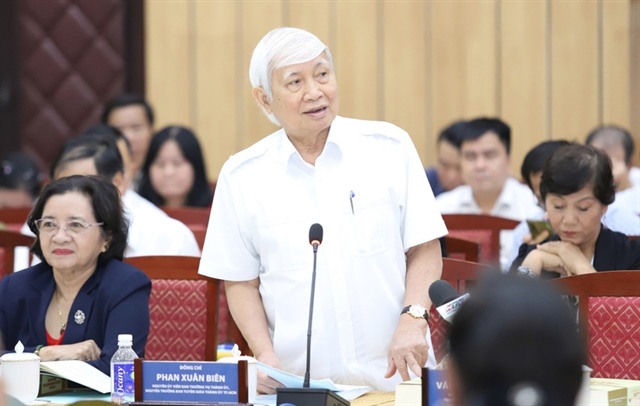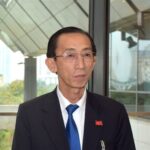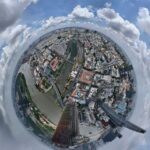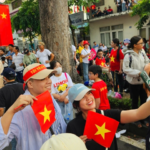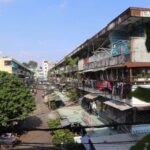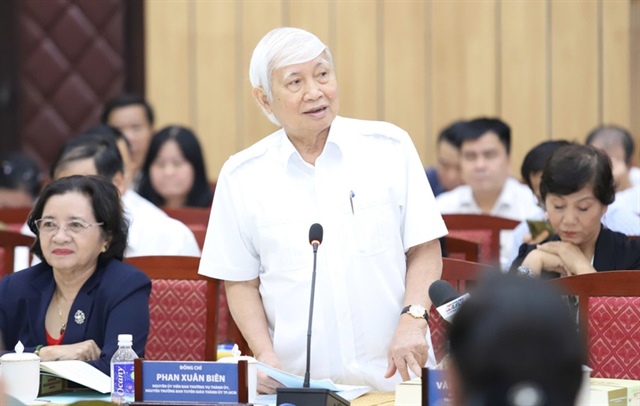
Prof. Dr. Phan Xuan Bien, Vice President of the Vietnam Historical Science Association, recalled the perilous period of Ho Chi Minh City in the early days after liberation – Photo: VGP/Vu Phong |
Entering a new era with opportunities and challenges, Ho Chi Minh City continues to promote the spirit of “leading the way” by accelerating digital transformation, attracting investment, developing modern infrastructure, and improving human resources. With flexible strategies and a long-term vision, Ho Chi Minh City aims to not only maintain its position as the country’s leading economic center but also become a smart, dynamic, and deeply integrated city globally.
Article 1: A Strong Half-Century Leap
Once heavily damaged by the war, Ho Chi Minh City has, over the past 50 years, continuously developed and affirmed its position as the country’s center of economics, finance, trade, culture, science, and technology.
Overcoming 740% Hyperinflation and the Story of “Breaking the Barriers”
In the early years after national reunification, Ho Chi Minh City faced countless difficulties. The rigid planned economic system and inappropriate reforms led to stagnant production and skyrocketing prices. Inflation reached 740% at one point, pushing millions of people into dire straits.
“For the first time in history, the people of Saigon had to eat diluted meals, from cassava to corn, sometimes up to 90% dilution. This was followed by a severe economic and social crisis,” Prof. Dr. Phan Xuan Bien, Vice President of the Vietnam Historical Science Association, recalled the perilous period of Ho Chi Minh City in the early days after liberation. The challenges seemed insurmountable.
However, the indomitable spirit and heroic character forged during the arduous and fierce war years were rekindled.
Mr. Bien recounted how the highest-ranking leaders of the early days of Ho Chi Minh City sought all possible solutions to provide for the people and promote production and business activities, pulling the city out of the crisis. They ensured rice rations for 3.5 million people and established a Food Procurement Team, traveling to the Mekong Delta, overcoming numerous “river barriers” and enduring harassment, threats, and even arrests to procure food at “agreed-upon prices.”
The City Party Committee conducted in-depth studies, surveys, and supported initiatives that were then considered “breaking the barriers,” encouraging a daring spirit and willingness to take responsibility. This approach helped break free from rigid thinking and find appropriate solutions to crucial and pressing issues in the city.
These “barrier-breaking” initiatives ensured food for the people, and the first City Party Committee passed two important resolutions: the 9th Resolution (1979) and the 10th Resolution (1980). These resolutions laid the foundation for change, creating conditions for production expansion and encouraging a culture of innovation from the grassroots.
The city advocated the principle of “finding all resources for production,” establishing the Direct Import-Export Company (Direximco) and the Cholon Import-Export Company (Cholimex) to mobilize capital for exports and import raw materials and equipment for production. The city boldly opened pre-existing warehouses, providing idle resources to enterprises.
As a result, the city witnessed the emergence of exemplary units operating under the “city mechanism,” such as the Southern Detergent Company, Phong Phu Textile Company, Thanh Cong Textile Company, Phuoc Long Textile Company, the City Food Company, the City Tobacco Enterprise, Saigon Beer, Sinco, and Caric. Tens of thousands of advanced workers, labor heroes, and socialist labor teams were recognized and honored by the State Council and the Council of Ministers.
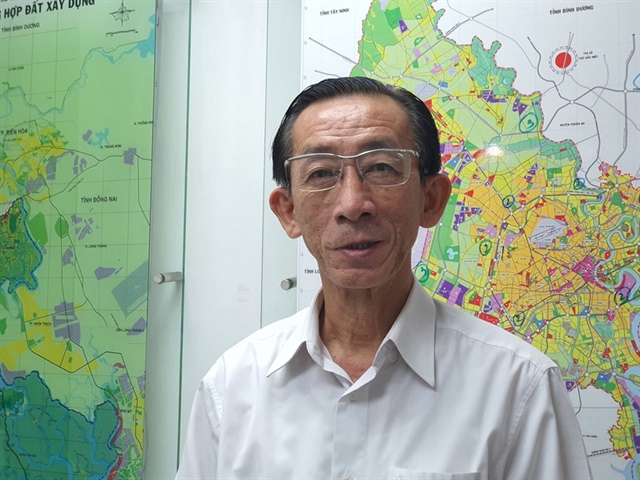
According to Prof. Dr. Tran Hoang Ngan, in the early years after liberation, the city went through a challenging and difficult period – Photo: VGP |
According to Prof. Dr. Tran Hoang Ngan, in the early years after liberation, the city went through a challenging and difficult period. It had to overcome the war’s aftermath, grapple with the challenges of the centralized planned economic mechanism, and face border conflicts. At the same time, it had to maintain political stability and ensure social welfare.
According to Mr. Ngan, during the ten-year period from 1975 to 1985, the city’s gross regional domestic product (GRDP, previously GDP) increased at an average rate of only 2.7% per year. However, a turning point came in 1986 when the Sixth National Party Congress resolved to build a socialist-oriented market economy with multiple economic sectors. The city strived to rise, developing its economy and society and gradually affirming its position and brand as the country’s economic locomotive.
The city was unshackled, like a “coiled spring” released. Various forms of enterprises emerged, and the city’s economy grew rapidly. From 1986 to 1990, the economic growth rate reached 7.82% per year, compared to 4.4% for the whole country. During the 1991-2010 period, the city’s economic growth rate averaged double digits, ranging from 11 to 12% per year.
In the 2011-2015 period, GRDP grew at an average rate of 7.22% per year, 1.2 times higher than the national average. However, bottlenecks began to emerge, indicating that the city’s scale had outgrown its infrastructure, especially in transportation.
In the 2016-2020 period, GRDP increased by an average of 6.41% per year (due to the impact of the COVID-19 pandemic, the city’s growth rate in 2020 was only 1.16%, lower than the national growth rate of 2.9%).
“Where the Good Land Attracts the Wise”
Rising from the ashes of war, Ho Chi Minh City has become a symbol of opportunity and renewal. Every street and corner breathes innovation and reflects the pioneering spirit of this land.
According to Dr. Tran Du Lich, Chairman of the Advisory Council for the Implementation of Resolution No. 98, Ho Chi Minh City is considered an international economic hub thanks to its geo-economic advantages. It boasts a well-developed economic infrastructure and is shaping into a modern megacity. The city is home to nearly a third of the country’s entrepreneurs and businesses and excels in science, technology, and human resource training.
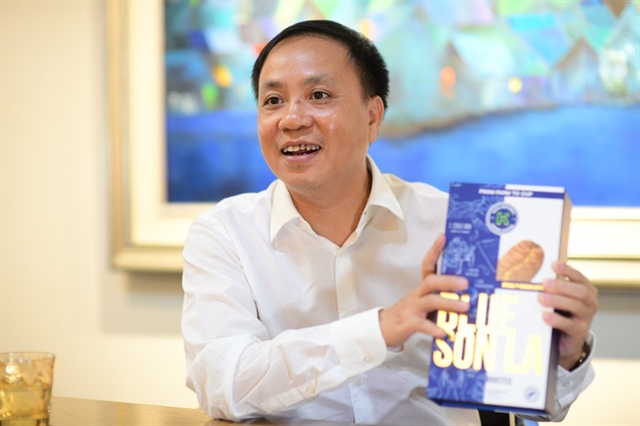
Mr. Phan Minh Thong, Chairman of Phuc Sinh Joint Stock Company, shared his reasons for choosing Ho Chi Minh City as his place of business |
Mr. Phan Minh Thong, Chairman of Phuc Sinh Joint Stock Company, a 1975-born entrepreneur from Hai Phong who studied in Hanoi, chose Ho Chi Minh City as his place of business.
When he started Phuc Sinh, Mr. Thong began with nothing. With limited capital, he had to learn everything from market research and customer acquisition to financial management. There were days when he served as the director, salesperson, and deliveryman all in one.
However, as the city rapidly developed and deeply integrated, Phuc Sinh also seized opportunities and leveraged its advantages. In the early years, the company’s revenue was only 200,000 USD, but by 2024, it had soared to 320 million USD.
Mr. Thong shared that his generation grew up during the country’s transition from a planned economy to a market economy. Despite the challenges, this period was also full of opportunities. The 1986 economic renewal opened the door to entrepreneurship and private enterprise development. “We were the pioneers who seized those opportunities to bring Vietnamese products to the world,” he proudly shared.
Ho Chi Minh City is not only a cradle for young entrepreneurs but also a pioneer in modern economic development models. Mr. Pham Binh An, Vice President of the Ho Chi Minh City Development Research Institute, noted that the city is in a phase of accelerating digital transformation and promoting new business models based on digital platforms, contributing to economic development. In 2023, the digital economy accounted for 21.5% of GRDP, an increase of 8.9% compared to 2020.
The city is also home to the headquarters of most large e-commerce businesses and supporting services in the country. It attracts many enterprises to participate in popular forms such as e-commerce platforms (Shopee, Lazada, Tiki), social media selling, and online platforms (Facebook, Instagram, Tiktok…).
Various sharing economy platforms have thrived, connecting users with service or product providers, including popular fields like transportation (Grab, Gojek, Be…), accommodation (Airbnb), car sharing (BeCar, GoCar…), and labor services (btaskee…). These platforms have gained traction by saving costs, optimizing resources, and generating additional income for participants.
Many businesses have also engaged in providing financial technology services through digital platforms, such as personal finance (digital asset management, money transfer), digital payments (online shopping, POS), alternative finance (peer-to-peer lending…), online insurance (life and health insurance…), and B2C financial services (banking, credit, insurance…).
Alongside technological development, the city has promoted the greening of the economy. Many enterprises have shifted to researching, developing, and trading environmentally friendly products and services to meet domestic and export demands. The city has implemented measures to encourage green business models, including energy service models, green transportation models, office equipment rental models, and the development of a circular economy.
Article 2: Breakthrough Reforms Affirm Ho Chi Minh City’s Position as the Country’s Economic Locomotive
Anh Tho – Khanh Linh
– 08:49 26/04/2025
“Ho Chi Minh City’s Reform Breakthrough: Asserting its Economic ‘Pioneer’ Status”
As Ho Chi Minh City embarks on a new phase of development, it faces not only a plethora of opportunities but also a slew of challenges. The city has begun to outgrow its infrastructure, resulting in bottlenecks that hinder its progress. To maintain its position as a vanguard, Ho Chi Minh City must embrace transformative reforms that match its expanding scale and ambition.
A Vision Proposal: ‘One Center, Three Corridors’ for Ho Chi Minh City’s Future Development
“The proposal to merge Binh Duong and Ba Ria – Vung Tau with Ho Chi Minh City to create a super-economic hub of Vietnam is a visionary move by the country’s leadership. To truly propel Ho Chi Minh City to new heights and unlock its full potential as the nation’s powerhouse, a bold and feasible long-term strategic vision is imperative. This vision transcends administrative boundaries, positioning Ho Chi Minh City at the heart of Vietnam’s economic development strategy. The article introduces the visionary concept of ‘One Center – Three Corridors’ for Ho Chi Minh City, aiming to fulfill this ambitious goal.”
The Pork Exchange: A $1 Billion Vision for Ho Chi Minh City’s Meat Industry
Ho Chi Minh City has the essential prerequisites to establish a pork trading floor and demonstrates the high feasibility of this model. With a daily consumption of approximately 10,000 pigs, the city’s annual expenditure on pork amounts to nearly VND 20 trillion.
The Ultimate Makeover: Unveiling the Revamped Ngo Gia Tu Apartment Project
The urgency of the situation demands swift action from District 10 authorities. The focus should be on finalizing compensation policies and relocation plans for residents affected by the Ngo Gia Tu apartment renovation project. With construction looming, timely and efficient execution of these plans is paramount.





![[Photo Essay]: Experts, Managers, and Businesses Unite to Forge a Path Towards Sustainable Green Industry](https://xe.today/wp-content/uploads/2025/07/z678592918-218x150.jpg)



















